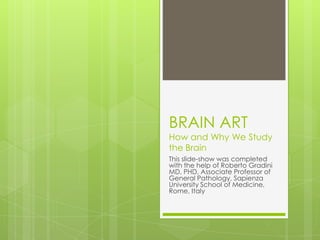
Brain art
- 1. BRAIN ART How and Why We Study the Brain This slide-show was completed with the help of Roberto Gradini MD, PHD, Associate Professor of General Pathology, Sapienza University School of Medicine, Rome, Italy
- 2. Why Study the Brain? In 1801, French psychiatrist Phillipe Pinel asked the question: “Does insanity depend upon organic lesion of the brain?” Pinel proceeded to perform numerous autopsies and eventually concluded: “no facts, yet clearly established, relative to the influence of the size and configuration of the cranium upon the faculties of the mind”.
- 3. Psychiatric Illnesses Are Diseases of The Brain In the past two decades advanced functional brain mapping technologies have become widely available, thus the so called “organic lesions” that Pinel failed to locate in the brains of mentally ill have been finally delineated so that we can now state with some certainty that psychiatric illness is caused by neural damage that we can characterize by the neuropathology involved.
- 4. How Do We Study The Brain? In vivo: by non-invasive neuroimaging studies such as Diffusion Spectrum Imaging (DSI), MRS, PET, SPECT In vivo: by microscopy of live mice brain In vitro: by microscopy of the dead brain In vitro: by cultured neurons
- 5. Limitations of Neuroimaging In vivo neuroimaging does not allow us to study individual neurons or their axons, because the resolution of MRI is 1 mm of the brain surface which contains about 1000 neurons. We are much better at visualizing white matter (axons) than gray matter (neurons) because axons lump together in tracts that are larger than 1 mm. The largest tract, corpus callosum, can be seen by naked eye. Connectomics is visualization of white matter tracts and for this reason is also called white matter tractography. Beautiful images of white matter tractography can be seen at: http://www.youtube.com/watch?v=CySDbTH46P4
- 6. Diffusion Spectrum Imaging Diffusion spectrum imaging (DSI) is a variant of diffusion-weighted imaging (DWI) that is sensitive to the diffusion directions of water molecules caused by crossing fiber tracts and thus allows more accurate mapping of axonal trajectories than other diffusion imaging approaches. DSI is being used in deriving the Connectome data because it visualizes bundles of axons traveling together.
- 7. Diffusion Spectrum Imaging (DSI) (Human Connectome Project) DSIvisualizes white matter tracts (bundles of axons) but not individual axons.
- 8. In Vivo Microscopy of Mouse Brain Two-Photon Microscopy is a fluorescence imaging technique that allows imaging of living brain up to a depth of about one millimeter. Two-Photon microscopy is a special type of confocal laser scanning microscopy (CLSM). Two-photon Images can be seen at: http://www.youtube.com/watch?v=W9bn_XYDbUo
- 9. In Vitro Microscopy Confocal laser scanning microscope (CLSM) is a valuable tool for obtaining high resolution images and 3-D reconstructions from in vitro individual brain neurons, axons and dendrites.
- 10. DENDRITIC SPINES - Ultra High resolution byConfocal Laser Scanning Microscopy
- 11. Confocal Laser Scanning Microscopy – dendritic spines More images at: denhttp://www.youtube.com/watch?v=zsp vdjjmWsY
- 12. Dendritic Spines by Confocal Laser Scanning Microscopy
- 14. Confocal Laser Scanning Microscope (CLSM): Dendrites with Spines
- 15. Transmission Electrone Microscopy (TEM) A transmission electron microscope (TEM) can magnify a sample up to one million times. The sample must be cut extremely thin. An electron beam is directed onto the sample to be magnified and some of the electrons pass through and form a magnified image of the specimen.
- 17. TEM: A Canopy of Dendrites
- 18. Transmission Electron Microscope (TEM): Dendrites “conversing”
- 19. Transmission Electron Microscopy (TEM): Mouse Neuron
- 20. TEM: Visualizing Actin in Dendritic Spines
- 21. TE: image of neuronal tissue. Segmented structures are: dendrite (yellow), chemically labeled buton (red) and a spine head (green). Blue arrows point to synapses.
- 22. TEM - DENDRITIC SPINES
- 23. Scanning Electron Microscopy (SEM) Scanning electron microscope (SEM) can magnify a sample up to 100,000 times. A sharply focused electron beam moves over the sample to create a magnified image of the surface. Some electrons in the beam scatter off the sample and are collected and counted by an electronic device. Each scanned point on the sample corresponds to a pixel on a television monitor; the more electrons the counting device detects, the brighter the pixel on the monitor is. As the electron beam scans over the entire sample, a complete image is displayed on the monitor. SEMs are particularly useful because they can produce three-dimensional images of the surface of objects
- 24. Scanning Electron Microscope (SEM)
- 25. Scanning Electrone Microscop (SEM): Striatum A Spiny Neuron
- 26. SEM: Dendritic Spine Density by Cortical Layer
- 27. Automated tape-collecting ultramicrotome (ATUM) (ATUM) is a new technique of obtaining ultrathin slices of brain tissue. - ATUM uses an electron opaque tape to continuously collect serial sections into ribbons of literally infinite length. -ATUM is invaluable for the study of the connectome.
- 29. Conclusions Neuroimaging technology has improved during the past two decades, but not enough as to allow us to visualize individual neurons, axons or dendrites. Human Connectome Project is done by various MRI techniques and is able to visualize bundles of axons traveling together (regional connectomics). Microscopy has a much higher resolution than MRI, but it does not allow us to visualize live human brain. In order to be able to visualize individual neuron connectomics in vivo, the future MRI machines will need to have 1000 times higher resolution than they have today.
